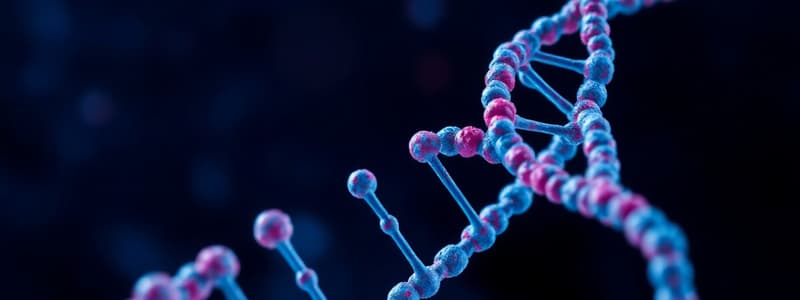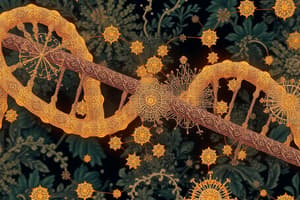Podcast
Questions and Answers
What is the main function of insulin in the body?
What is the main function of insulin in the body?
- To produce red blood cells
- To regulate blood sugar levels (correct)
- To build muscle tissue
- To break down fats
Which of the following is NOT a type of bond found in molecules?
Which of the following is NOT a type of bond found in molecules?
- Hydrogen bond
- Covalent bond
- Ionic bond
- Gravitational bond (correct)
Which of the following correctly describes the order of biological structures in the human body from smallest to largest?
Which of the following correctly describes the order of biological structures in the human body from smallest to largest?
- Tissue, organelle, cell, organ, organ system, organism
- Organelle, cell, tissue, organ, organ system, organism (correct)
- Organ, organ system, tissue, cell, organelle, organism
- Cell, organelle, tissue, organ, organ system, organism
What is the process by which plants take in water from the soil?
What is the process by which plants take in water from the soil?
Which of the following is NOT a type of muscle found in the human body?
Which of the following is NOT a type of muscle found in the human body?
What is the process by which sperm and egg cells combine?
What is the process by which sperm and egg cells combine?
Which of the following describes the function of the cardiovascular system?
Which of the following describes the function of the cardiovascular system?
What is the process by which plants convert light energy into chemical energy?
What is the process by which plants convert light energy into chemical energy?
Which of the following is an example of a heterogeneous mixture?
Which of the following is an example of a heterogeneous mixture?
What is the function of the respiratory system?
What is the function of the respiratory system?
Describe the structure and components of DNA.
Describe the structure and components of DNA.
Describe the structure of the sex chromosomes.
Describe the structure of the sex chromosomes.
Define mitosis, meiosis, mutation, non-disjunction.
Define mitosis, meiosis, mutation, non-disjunction.
Describe the parts of an atom and how the electrons move.
Describe the parts of an atom and how the electrons move.
Describe different types of bonding.
Describe different types of bonding.
Describe an element.
Describe an element.
Define science.
Define science.
Define biology.
Define biology.
Define hypothesis.
Define hypothesis.
Describe the different types of chemistry?
Describe the different types of chemistry?
Define acidity, basicity.
Define acidity, basicity.
Define eukaryotic cell
Define eukaryotic cell
Describe the function of ATP.
Describe the function of ATP.
Describe filtration, diffusion, osmosis, active transport.
Describe filtration, diffusion, osmosis, active transport.
Define reactant, solution, precipitate, product, compound, chemical reaction.
Define reactant, solution, precipitate, product, compound, chemical reaction.
Give examples of homogeneous and heterogeneous mixtures.
Give examples of homogeneous and heterogeneous mixtures.
Describe the process of evolution.
Describe the process of evolution.
Describe hydrogen bonding to form water, carbon dioxide carbon monoxide.
Describe hydrogen bonding to form water, carbon dioxide carbon monoxide.
Define mass, weight, density, solid, liquid, gas, matter, mixture.
Define mass, weight, density, solid, liquid, gas, matter, mixture.
Describe the structure and function of bacteria, viruses.
Describe the structure and function of bacteria, viruses.
Describe the structure of an animal cell.
Describe the structure of an animal cell.
Organize the biological structures in the human body from smallest to largest.
Organize the biological structures in the human body from smallest to largest.
Describe the function of the skeletal, muscular, respiratory, cardiovascular, immune, integumentary, endocrine, nervous, reproductive, digestive systems.
Describe the function of the skeletal, muscular, respiratory, cardiovascular, immune, integumentary, endocrine, nervous, reproductive, digestive systems.
Describe the anatomy of and blood flow though the cardiovascular system.
Describe the anatomy of and blood flow though the cardiovascular system.
Describe the parts of blood.
Describe the parts of blood.
Describe the types of blood cells.
Describe the types of blood cells.
Describe the types of muscle in the body.
Describe the types of muscle in the body.
Describe the function of insulin.
Describe the function of insulin.
Define fertilization, ovulation, menstruation.
Define fertilization, ovulation, menstruation.
Describe the anatomy and function of the nose, mouth, hair, nails.
Describe the anatomy and function of the nose, mouth, hair, nails.
Describe the categories of plants.
Describe the categories of plants.
Describe the process of water uptake by plants.
Describe the process of water uptake by plants.
Describe the air exchange in a leaf.
Describe the air exchange in a leaf.
Describe the structure and function of a plant cell.
Describe the structure and function of a plant cell.
Describe the function of cellulose.
Describe the function of cellulose.
Describe how plants are pollinated?
Describe how plants are pollinated?
Describe the process of photosynthesis, respiration.
Describe the process of photosynthesis, respiration.
Describe ecosystem.
Describe ecosystem.
Flashcards
Structure of DNA
Structure of DNA
DNA is a double helix made of nucleotides consisting of a sugar, phosphate, and nitrogenous base.
Mitosis vs Meiosis
Mitosis vs Meiosis
Mitosis is cell division for growth; meiosis is for producing gametes with half chromosome number.
Eukaryotic cell
Eukaryotic cell
A cell with a nucleus and organelles, such as those in plants and animals.
Acidity and Basidity
Acidity and Basidity
Signup and view all the flashcards
Function of ATP
Function of ATP
Signup and view all the flashcards
Types of blood cells
Types of blood cells
Signup and view all the flashcards
Photosynthesis process
Photosynthesis process
Signup and view all the flashcards
Function of Insulin
Function of Insulin
Signup and view all the flashcards
Atom structure
Atom structure
Signup and view all the flashcards
Process of evolution
Process of evolution
Signup and view all the flashcards
Structure of sex chromosomes
Structure of sex chromosomes
Signup and view all the flashcards
Define mutation
Define mutation
Signup and view all the flashcards
Define non-disjunction
Define non-disjunction
Signup and view all the flashcards
Define element
Define element
Signup and view all the flashcards
Define science
Define science
Signup and view all the flashcards
Define biology
Define biology
Signup and view all the flashcards
Define hypothesis
Define hypothesis
Signup and view all the flashcards
Types of bonding
Types of bonding
Signup and view all the flashcards
Define acidity
Define acidity
Signup and view all the flashcards
Define basidity
Define basidity
Signup and view all the flashcards
Define prokaryotic cell
Define prokaryotic cell
Signup and view all the flashcards
Describe filtration
Describe filtration
Signup and view all the flashcards
Describe diffusion
Describe diffusion
Signup and view all the flashcards
Describe osmosis
Describe osmosis
Signup and view all the flashcards
Define reactant
Define reactant
Signup and view all the flashcards
Define solution
Define solution
Signup and view all the flashcards
Define precipitate
Define precipitate
Signup and view all the flashcards
Define product
Define product
Signup and view all the flashcards
Define compound
Define compound
Signup and view all the flashcards
Describe homogeneous mixture
Describe homogeneous mixture
Signup and view all the flashcards
Describe heterogeneous mixture
Describe heterogeneous mixture
Signup and view all the flashcards
Define mass
Define mass
Signup and view all the flashcards
Define weight
Define weight
Signup and view all the flashcards
Define density
Define density
Signup and view all the flashcards
Define matter
Define matter
Signup and view all the flashcards
Define mixture
Define mixture
Signup and view all the flashcards
Function of bacteria
Function of bacteria
Signup and view all the flashcards
Describe viruses
Describe viruses
Signup and view all the flashcards
Describe animal cell anatomy
Describe animal cell anatomy
Signup and view all the flashcards
Biological structures order
Biological structures order
Signup and view all the flashcards
Function of skeletal system
Function of skeletal system
Signup and view all the flashcards
Function of muscular system
Function of muscular system
Signup and view all the flashcards
Function of respiratory system
Function of respiratory system
Signup and view all the flashcards
Function of cardiovascular system
Function of cardiovascular system
Signup and view all the flashcards
Function of immune system
Function of immune system
Signup and view all the flashcards
Function of integumentary system
Function of integumentary system
Signup and view all the flashcards
Function of endocrine system
Function of endocrine system
Signup and view all the flashcards
Function of nervous system
Function of nervous system
Signup and view all the flashcards
Function of digestive system
Function of digestive system
Signup and view all the flashcards
Define fertilization
Define fertilization
Signup and view all the flashcards
Define ovulation
Define ovulation
Signup and view all the flashcards
Define menstruation
Define menstruation
Signup and view all the flashcards
Categories of plants
Categories of plants
Signup and view all the flashcards
Process of water uptake by plants
Process of water uptake by plants
Signup and view all the flashcards
Describe air exchange in a leaf
Describe air exchange in a leaf
Signup and view all the flashcards
Structure of plant cell
Structure of plant cell
Signup and view all the flashcards
Function of cellulose
Function of cellulose
Signup and view all the flashcards
Process of pollination
Process of pollination
Signup and view all the flashcards
Process of respiration
Process of respiration
Signup and view all the flashcards
Describe ecosystem
Describe ecosystem
Signup and view all the flashcards
Study Notes
DNA and Chromosomes
- Describe the structure and components of DNA.
- Describe the structure of sex chromosomes.
Cell Division and Genetics
- Define mitosis, meiosis, mutation, and non-disjunction.
Atom and Bonding
- Describe the parts of an atom and electron movement.
- Describe different types of bonding.
Chemistry Basics
- Describe elements.
- Define science and biology.
- Define hypothesis.
- Differentiate types of chemistry (likely implying different branches, e.g., organic, inorganic).
- Define acidity and basicity.
- Define eukaryotic and prokaryotic cells.
Cellular Processes and Energy
- Describe the function of ATP.
- Describe filtration, diffusion, osmosis, and active transport.
- Define reactants, solutions, precipitates, products, and chemical reactions.
- Give examples of homogeneous and heterogeneous mixtures.
- Describe the process of evolution.
- Describe hydrogen bonding (and its role in forming water, carbon dioxide and carbon monoxide).
- Define mass, weight, density, solids, liquids, gases, matter, and mixtures.
Biological Structures and Functions
- Describe the structure and function of bacteria and viruses.
- Describe the anatomy of animal cells.
- Organize biological structures in the human body from smallest to largest.
- Describe the function of skeletal, muscular, respiratory, cardiovascular, immune, integumentary, endocrine, nervous, reproductive, and digestive systems.
- Describe the anatomy of and blood flow through the cardiovascular system.
- Describe the parts of blood.
- Describe types of blood cells.
- Describe types of muscle in the body.
- Describe the function of insulin.
- Define fertilization, ovulation, and menstruation.
- Describe the anatomy and function of the nose, mouth, hair, and nails.
Plant Biology
- Describe categories of plants.
- Describe the process of water uptake by plants.
- Describe air exchange in a leaf.
- Describe the structure and function of a plant cell.
- Describe the function of cellulose.
- Describe plant pollination.
- Describe photosynthesis and respiration.
- Describe ecosystems.
Studying That Suits You
Use AI to generate personalized quizzes and flashcards to suit your learning preferences.




